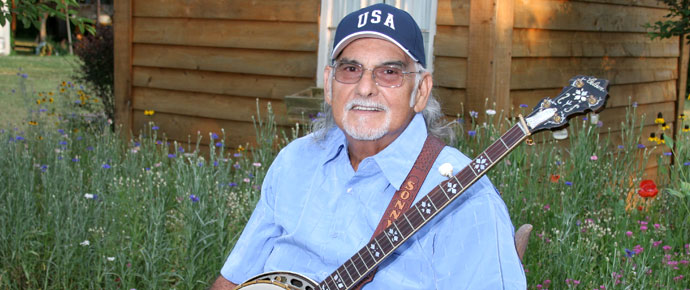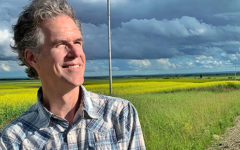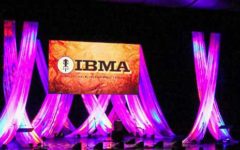
Ask Sonny Anything is a recurring feature where our readers pose questions to the great Sonny Osborne, one half of the iconic Osborne Brothers who redefined bluegrass music in the 1960s, and noted banjo maven and collector of fine prewar instruments. Everyone is encouraged to pose queries of your own each week in the comments, about his history in the music, his wealth of banjo knowledge, or regarding any life advice you might be needing.
A couple weeks ago someone asked about Bill Monroe’s baseball teams and I couldn’t offer much actual input but my friend and great singer, Charlie Sizemore came through with this bit of information. Thank you Charlie!
Mr Sonny,
I overheard Monroe talking of baseball players in his band and he spoke of Jack Cooke having a “drop ball,” that is, a ball that drops just in front of the hitter. Monroe said it was like a ball rolling off a table. I suspect today we’d call this pitch a sinker, but I’m not sure. Anyway I found this hard to believe until we were at a festival where there were gloves and balls. I picked up a fielders glove and caught about three pitches from Jack. Monroe was right. That ball dropped a foot just before it reached me. And, damn, Jack threw hard. After very few pitches I gave up and it was days before my left hand recovered.
Look forward to your columns. Always something interesting and often causing me to remember stuff.
Happy Christmas to you and yours.
Charlie
=======================================================================
Charlie Sizemore, one of my best and old time friends, was gracious enough to allow me to talk him into printing this. Thank you Charlie, I’m indebted.
=======================================================================
Sonny,
You’ve recently discussed a moment in your playing career when you knew that you’d lost a step, wasn’t able to play at a level you had been, and it was then time to move on.
But you are widely regarded as one of the best players ever and us recreational players, striving to improve, look to your playing as a guide. When you look back now, what album, if you can choose just one, best exemplifies your playing at it’s best. What do YOU regard as your best playing? You’ve mentioned the early Earl period which you consider to be the best of his repertoire. What do you feel is your best period?
A video of you playing a medley in Sweden in 1980 is widely circulated. I love to watch it again and again because it’s such wonderful playing, but maybe you might look at yourself in a more critical light and might say, no that’s not my best playing. I’m very interested in knowing what you feel is your best playing.
Thanks for the great column. I’m enjoying it!
—–
The Sweden medley, played on a SONFLOWER model Stelling banjo, owned now by Wayne Rice of San Diego, CA. I wish I had kept it. That medley has been viewed over 2 million times. Whoda thought? That is some of my best, along with The Essential Bluegrass Album we did with Mac Wiseman and the Bluegrass Collection album, both on the CMH label. I thought I was pretty consistent throughout so it’s rather tough for me to say this… or that… is better. I’m speaking as an outsider so as not to sound a big headed or conceited person, which I assure you I am not. I have NO ego nor conceit. You asked a question and I attempted to answer as best as my limited brain capacity will allow! To me there are two categories of “the best banjo” players. Melodic and traditional. Traditional would be Rob McCoury, Kristin Benson, and several after that. Melodic, or jazz would be Jens Kruger, Bela Fleck, and Tony Trischka.
—–
Sonny:
I started playing banjo a bit later in life, been playing for about 15 years, and listening to Earl’s playing almost daily during that time. I feel like I always discover something new in his playing, even after hearing it many times. I too listen to your playing almost daily. You inspire me to continue to work on the little things. Your intro to Pictures On The Wall is just one example of clear and distinct separation of notes. Thanks for inspiring a recreational player to be better.
I think you have said that you focused on learning everything Earl played, basically note for note. I am old enough to remember a world before digital media, where you can take music with you, listen to it anywhere, even using software to slow down a song, so I wonder, how you would learn a song when you were learning? Were you able to hear it played at performance speed on a record and pick it up that way? While learning, would you write any of it out as you learned? Did you play with others who taught you licks you heard? As someone who uses tablature mostly, I’m interested in how you learned songs. I’m also interested in trying to learn by ear and wonder if that’s the way you learned.
Thank you. Perry
Perry…Thanks for joining us and thank you for the kind words. To answer about learning. As a 10 year old, Bobby was playing with Larry Richardson. This is 1947 remember. I heard a banjo played, up close. I wanted to do that. By 13 I was focused on Earl and Rudy Lyle. I only had a 78rpm record player (later a 45rpm) and so I got everything Earl and Rudy played and just played them over and over until the banjo breaks turned white, I focused on every note, every string. I heard what they did as best I could and it became drilled in my mind, and I tried to do the same. There was only a couple banjo players in the Dayton area and from what I could tell, they were at the same level as I so there was no one to ask. Brother Bobby had been up close to Earl and had seen as well as heard what Earl did with his right hand. After hearing me play, he showed me the backward roll and that made the timing all fit together. That was the game changer for me. I learned everything by ear, no writing it out, no machine to slow it down, just listening over and over. And then practicing for untold hours…until my fingers bled. YOU GOTTA WANT IT!
s
—–
Sonny, back when you first started playing the Gitjo and wanted to change the pattern on the neck to a Granada like pattern. We talked at Renfro Valley and you asked if I could engrave a Mastertone Block style piece of pearl saying Gitjo…. I did and gave it to you. You wanted to pay me, and I said no, I considered it an honor to do this for you. You said I’ve got something that I’ll give you… Later you told me of the remnants of a 5 string neck that I think you said that Red Allen had gotten at a yard sale or something like that…. but it was a mahogany stub of a neck with the peghead broken, the rod cut off at about the 1st fret…. Frank Neat had taken the fingerboard off and saved the pearl and when you gave it to me you said I might could make a lamp or something out of it. I took it home and sat it beside the TV for about 6 or 8 months…then I realized….they graft fiddle pegheads….so the search began……. After a lot of planning, I did bring it back to life and its in the banjo I play and has been there since the late ’80s. I spliced a plectrum peghead on to it and it’s a fine neck…. My question is what do you remember about the banjo before the peghead was broken off and what happened to the remainder of the banjo…
Doug H.
Hey Doug…Man, what a memory you have. Sometime in the late ’60s Red was in town and called me to have lunch. Yeah, I know, hard to believe, but as I remember I bought lunch. Anyway, after we talked for a few hours I started home and he said he had something to show me that he had picked up at a garage sale. It was that neck. He had sold the rest of the banjo, as I remember how he described it to be a 3 style Gibson. He gave me the broken neck. I don’t remember the Frank part of it but the rest of the story makes sense. I haven’t looked lately but I think the GITJO inlay is still there. Interesting that you could find a peghead and had the good sense to have it grafted on that neck. I would never have thought to do that. Maybe you could send along a picture. I would love to see the finished product.
s
—–
Sonny, can you share on of your favorite Holiday memories with us?
Wendy C.
My MERRY CHRISTMAS is many. Daddy and Mother, Bobby, Louise, and I during the ’40s and some of the ’50s. After which we all started to work, and spread. 1958 found me married, with Judy and I living in an 8 by 43 single wide trailer. She was working at Delco in Dayton, me working at WWVA in Wheeling (If you want to call it that) and barely making enough to live. One Christmas Judy and I decided to refrain from getting a gift for one another. We had a little tree and whist snooping I spotted a watch hanging on the back of the tree. This was Christmas eve, I panicked and took off and the only thing open was the Biltmore Hotel gift shop. I found a set of ear rings for $25.00…I had 30 and that was all. Hard Times for sure.
Then the good times with Steve (1960) and Karen (1962) and coming to Nashville. We arrived November 22, 1964. Bobby and I left immediately after unloading my belongings and his in the garage of the house Judy and I had purchased at 219 Harbor Drive. Bobby’s house at 223 Harbor had closed but was not going to be empty for another week. So Judy, Pat, and Robby loaded as much as possible into our house and when the other house was empty they..those three..carried, drug, and used every means at their disposal, taking Bobby’s furnishings to his house. Then, as stated above, Bobby, Benny Birchfield, and I were gone on a California tour for 21 days. When we returned everything was, almost out of turmoil by then, but I must add here that much had happened whilst I’d be gone. Let’s just say it worked out alright and leave it at that.
Naw…I need to say more.
Judy and Pat while trying to find NES without asking anyone, had wound around on several streets and ended up at the Capitol and of course promptly told to leave. So, they left and with all the twists and turns guess where they wound up…again. On the Hill. After repeating these moves several times and winding up at the Capitol, and with the guard a bit more agitated each time, on their final approach the guard headed their way as soon as he saw them round the last curve yet again. Saying, “ladies, y’alls gonna have to get offa this hyer hill or get yo silly selves arrested.” So, with Pat and 4 kids laughing her things off, and Judy trying not to laugh, while saying… “Dammit I’m trying!” Now, lets just say it all worked out…. and I spent 43 years as a member of the Grand Ole Opry.
s
—–
Sonny,
Thank you for mentioning my uncles, The York Brothers, in one of your answers recently. A statement then a question…Voices In Bluegrass is and always has been my favorite bluegrass album, period. What an album!
My question for you is knowing how you feel about Earl Scruggs I am curious from your point of view as to what did he do that set him apart from all other banjo players that have followed him?
Thank you for taking the time to answer the questions that come your way.
George York
George York…I listened to George and Leslie on the Opry before I so much as thought about playing a banjo or being a member of the Grand Ole Opry. I never knew what happened to them and why they just disappeared. Voices in Bluegrass was the turning point for us. We really got to show what we could do. It worked well for us.
Earl set himself aside from the rest because he had the best right hand, his timing was superior to everyone, and he had ice water in his veins…. meaning….. he could bring it while on the big stage. Put him on a stage in front of 200,000 and he could do it or 15 and he could also do it. That’s easier said than done. I know, mention Dear Old Dixie and I fold up like an accordion. BUT! my Dad told me to find my weaknesses and stay away from them, that way no one will ever know that you have them. I did that. Dear Old Dixie was it and I tried to play it one time. First and last…. yet I know every note and could play every note…. go figger! Earl was the first to do it and he had Monroe and the Opry, WSM to promote the banjo. I’ve heard people say he was not the first, so…ok. He brought it to us first and HELLO, He could pick, my brother, he COULD PICK THE BANJER. The first time I saw him play he scared the mortal daylights out of me!!!!!
Thank you John and Terry for allowing me to do this
S
If you have something you would like to ask Sonny, be sure to post it in the comments below, or send it to us directly.







